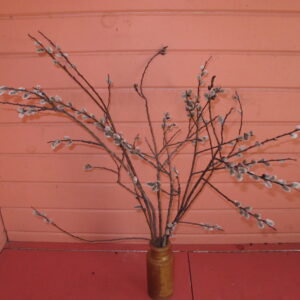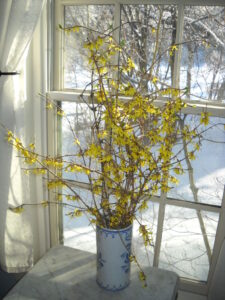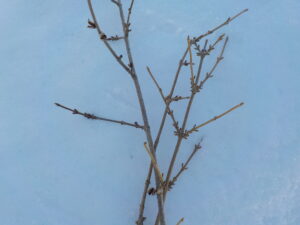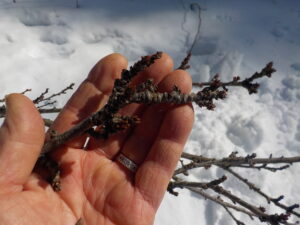Bringing Spring into the House
Posted on Wednesday, March 22, 2023 · Leave a Comment

Pussy willows in a dry vase
Even though spring has arrived according to the calendar, I fear winter is not done with us yet. Mother Nature is full of tricks, so I am not packing away my snow shovel just yet. But to reassure me that she will provide us with flowers this spring, I am forcing her hand a bit. Or should I say, forcing some woody stems to blossoms indoors now.
Each spring when winter seems to be carrying on forever, I cut stems of early-blooming trees and shrubs and bring them into the house to enjoy their blossoms. If you wish to try this, you need to know which trees and shrubs to use, and learn to identify buds that will produce flowers, not just leaves.

Forsythia forces easily indoors now
The easiest to force are forsythia and pussywillows. But it is also possible to force magnolias, rhododendrons and azaleas, apples and crabapples, cherries, plums, dogwood, spirea and peach. Of course cutting stems off your young peach or plum tree will reduce your fruit crop.
Trees and shrubs that bloom early in the season are quicker to produce their flowers. Shrubs like hydrangeas that bloom in late summer or fall will not bloom now, no matter what you do. I’ve never had much luck with lilacs, though perhaps if I tried closer to bloom time it would work.
In general, flower buds tend to be bigger and fatter than leaf buds. Apple and crabapple trees produce flower buds on short “fruit spurs” but not on those tall water sprouts that appear each summer. So if you are pruning your apples now, look for branches with short spurs and fat buds. Keep those, and bring them into the house.
I lost a plum tree this winter – it broke under the weight of snow and ice. It took 20 years from the time I planted a bare root twig to the time it first produced fruit. This year it was loaded with fruit spurs and I was looking forward to a big crop of plums. No matter, these things happen. I am making the best of it by cutting lots of stems with fruit spurs and placing them in vases in the house. I should get a multitude of blossoms in a few weeks.

Forsythia with flower buds in pairs
I am also cutting stems from forsythia bushes to bring in the house. Forsythia is one of the first to bloom outside, and one of the easiest to force inside. It produces bright yellow flowers in quantity. Look for branches with pointy buds on stems that are at least 2 years old. You will see skinny new-looking branches that grew last year. They probably won’t produce flowers. Stems that are closer in diameter to pencils are what you want. Older branches have stems growing out of them, often with flower buds.
Then there are the pussy willows. . What we call pussywillows are actually the male catkins – pollen-producing parts – of two species of willows (Salix caprea and Salix discolor). Both grow wild, and are available at nurseries.
Pussy willows, like all willows, like wet, swampy areas. They will grow up to be small trees, but can be kept to a manageable size with yearly pruning – and now is a good time to do so. The more you trim your pussy willows, the more vigorous and productive they will be. Left unpruned, pussy willows can easily reach 20 feet tall. Since they bloom on their upper branches, picking good-looking stems can be difficult unless you have a pole pruner.
An established pussy willow is next to impossible to kill. If you have wild pussy willow that is tall and gangly, you can take a saw and cut it all right to the ground. It will come back. It can grow four feet or more in a single season.

Fruit buds on plum tree
If you see yellow dust on your pussy willows, they are already producing pollen. So if you are allergy-prone, don’t pick stems with yellow on them. But you can halt pussy willows from producing pollen: pick them at their peak of beauty, and place them in a dry vase. They will stay looking the same for a year. If you pick them before they are fully developed, put them in a vase with water to let them mature. Drain off the water when the little gray kitties are at their cutest.
In 2005 I worked as a volunteer on an organic farm in the Dordogne region of France that grew willow for making baskets. I worked through an organization called Willing Workers on Organic Farms (
www.wwoof.org). In exchange for 4-6 hours of work each day I got room and board, lived with a family, and learned a lot about willows – including how easy it is to root them.
To root willows, cut 8-12 inch sections of vigorous young stems in May or June. Strip off the lower leaves, and push the stems into moist soil, leaving just 2 inches above ground. Roots will develop at each node (where leaves start) on the stem below ground; new stems and leaves will grow above ground, so long as you leave at least one node above ground. Depending on your soil, you may need to poke a hole in the ground with a screwdriver before inserting your willow stem; be sure the ground is firmed up around it when you are done.
So cut some stems to flower and chase away the late winter blues. It’s easy, and now is the time to do it.






